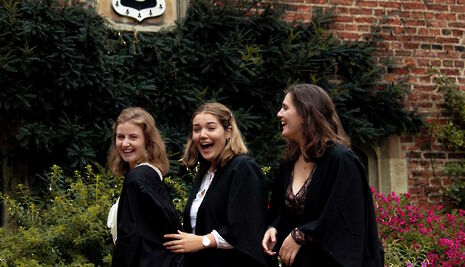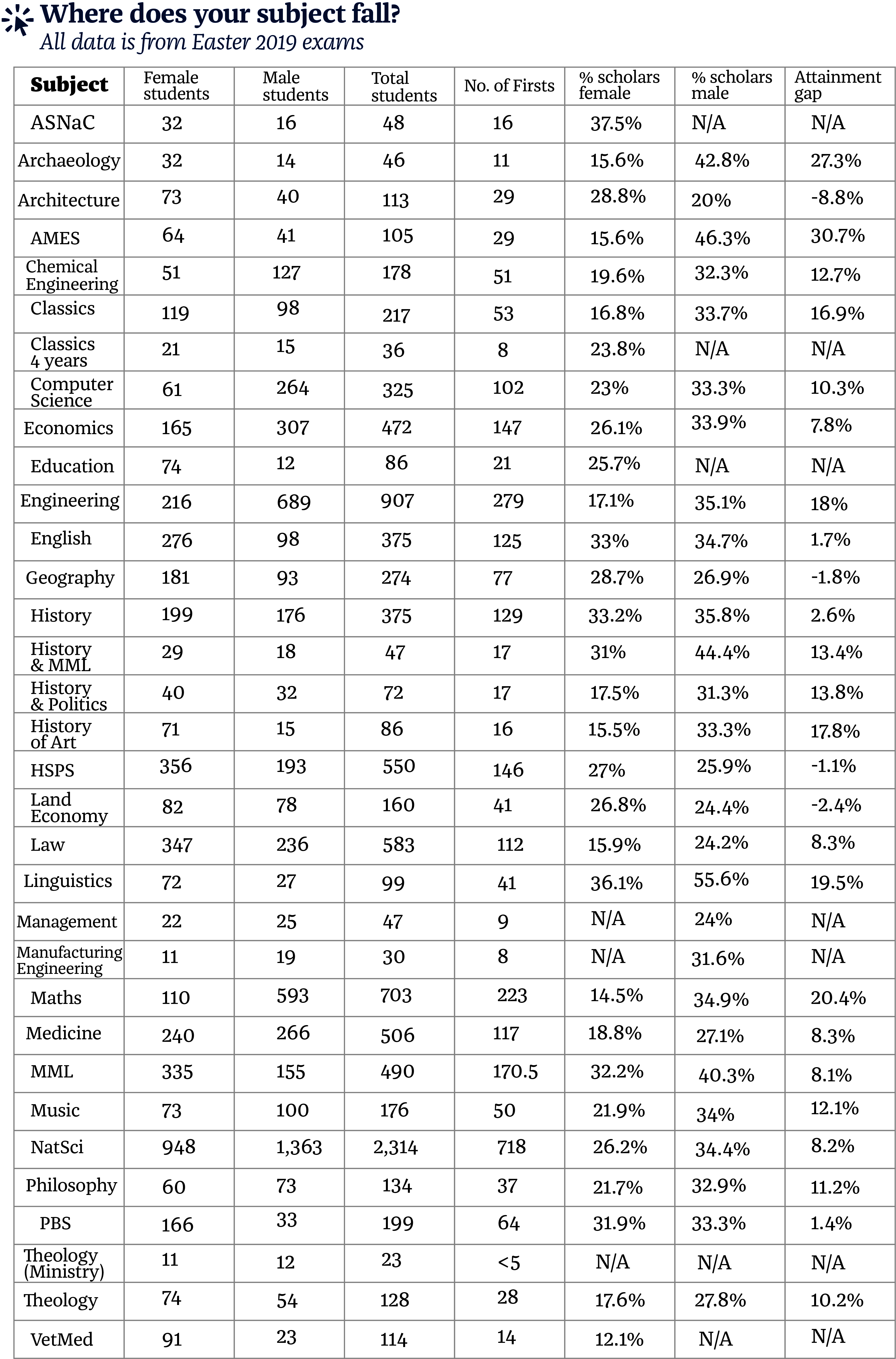Men lead women by 8% in receipt of Firsts
Since records began, men have been more likely than women to receive a First in their undergraduate examinations

33.0% of all men who sat undergraduate examinations in the 2018/19 academic year received a First, compared to just 24.7% of all women, according to data obtained through a Varsity Freedom of Information request. Conversely, around 58.1% of women were awarded a 2.i, compared to 47.9% of men. 82.6% of women attained at least a 2.i, and 80.9% of men.
See how your Tripos stacks up on gender attainment.
Since records began in 2011, male undergraduates at Cambridge have been more likely to receive a First in their examinations than women, while female undergraduates have consistently been more likely than men to receive a 2.i.
In the last 9 years, the male lead in the proportional receipt of Firsts has dropped by around 1.4 percentage points, from 9.7% to 8.3%. The greater likelihood that women receive a 2.i has dropped by less than a percentage point.
Last year, as in the years prior, a smaller overall difference in attainment existed in the lower pass grades: 11.1% of men and 9.6% of women received a 2.ii, and 2.4% of men and 1.5% of women received a third.
A higher proportion of men achieved a First in at least 22 out of 37 subject areas, while a higher proportion of women received a First in at least 4. Varsity was unable to calculate the attainment gap for students receiving Firsts in the remaining 7 subjects, for which the University gave ‘fewer than five’ as a figure to avoid the risk of identifying students.
In the majority of subject areas, where a higher proportion of men achieved a First, a higher proportion of women achieved a 2.i. However, in Maths, Computer Science, Economics, and Philosophy a higher proportion of men achieved both Firsts and 2.is than women.
Proportionally, more men than women achieved Firsts in at least 14 arts and humanities subjects out of a possible 24, and 8 STEM subjects out of a possible 9.
Responding to the findings, a spokesperson for the University pointed to Cambridge’s Access and Participation Plan, approved by the OfS early last month, where “there is a specific commitment to closing all attainment gaps."
CUSU Women’s Officer Kate Litman told Varsity that “the burden of responsibility to reform teaching and assessment methods and end the disparity of women’s experiences at Cambridge lies with the University and individual faculties.”
Faculties must “confront their gender attainment gaps and demonstrate that they are willing to deploy creative solutions and rethink what a degree at Cambridge has to look like,” Litman noted.
In at least 14 subject areas last year, the proportion of men who received a First was at least 10 percentage points higher than it was for women.
The biggest attainment gap was in Asian and Middle Eastern Studies (AMES) examinations, whose cohort was 61% female, where the proportion of men who received a First was 30.7 percentage points higher than the proportion of women who received the same.
This was closely followed by Archaeology, with a 70% female cohort, where men led women by 27.3 percentage points in getting a First.
Of these 14 subjects where men had a significant lead on women, 4 were STEM subjects and the other 9 were arts and humanities subjects.
The biggest lead women had on men in achieving a First was in Architecture, where the percentage points’ difference was 8.8. Following this, the biggest lead female students had on their male counterparts was in Land Economy, with a percentage point difference of 2.4.
Meanwhile, a higher proportion of women achieved a 2.i in at least 26 subject areas last year.
The biggest lead women had on men in receiving 2.is was in History of Art, where the percentage point difference was 27.0. The widest attainment gap was seen, therefore, within AMES, where men had a 30.7 percentage point lead on the proportional receipt of Firsts.
This difference in attainment existed only in the top two grades: 11.1% of men and 9.6% of women received a 2.ii, and 2.4% of men and 1.5% of women received a third. This has been the case since 2011, according to the University’s annual report on the undergraduate examination results of UK domiciled students.
How has the attainment gap changed since 2011?
The attainment gap within the top grade has closed only slightly in almost a decade. In 2011, the proportion of men who received Firsts was some 9.7 percentage points greater than the proportion of women who received them. In 2019, men remained 8.3 percentage points ahead.
Meanwhile, women have been more likely to receive a 2.i than men for at least the past 9 years. The greater proportion of women receiving a 2.i has dropped by less than a percentage point in this period, from an 11-point difference in 2011 to a 10.1-point difference in 2019.
Litman told Varsity that “degrees which are overwhelmingly exam focussed and courses with unmanageable workloads let down many students, not just women. Something needs to give, and the University must stop seeing elements of the degree structure as immovable."
“Student academic reps are well placed to push for changes such as more diverse modes of assessment, course content which doesn’t relegate women’s contributions, and transparent reporting on gender attainment."
“The Women’s Campaign and the Education Officer are working to produce guidance for Faculty Reps to support them in holding their faculties to account on gender attainment,” she added.
 Rosie Bradbury
Rosie Bradbury
 Features / How sweet is the en-suite deal?13 January 2026
Features / How sweet is the en-suite deal?13 January 2026 Arts / Fact-checking R.F. Kuang’s Katabasis13 January 2026
Arts / Fact-checking R.F. Kuang’s Katabasis13 January 2026 News / SU sabbs join calls condemning Israeli attack on West Bank university13 January 2026
News / SU sabbs join calls condemning Israeli attack on West Bank university13 January 2026 Comment / Will the town and gown divide ever truly be resolved?12 January 2026
Comment / Will the town and gown divide ever truly be resolved?12 January 2026 News / Uni members slam ‘totalitarian’ recommendation to stop vet course 15 January 2026
News / Uni members slam ‘totalitarian’ recommendation to stop vet course 15 January 2026










